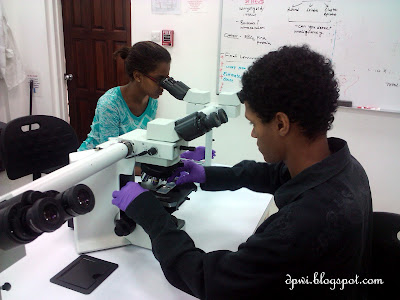I keep promising myself to update, and then I fail to do so. I conclude this, perhaps, has been my worst year post-wise but it's definitely not for lack of wanting. To those that keep passing by to see what's new, I appreciate it and I shall try to post more frequently henceforth.
***
While school has concluded its spring semester, I am yet engaged in another project. This summer I am working with ECBREC (Eastern Caribbean Bee Research & Extension Center) on a research project involving the status of honey bees locally.
Why, you ask? Because honey bees are a very important part of the food chain on the lower scale of things. For one, they are good pollinators. In fact, they are better pollinators than wasps and other smaller bees. Pollen grains cling to their legs much more and with ease than their smaller counterparts. So the more honey bees present on your farm, more potential pollination to occur. Aside from pollination, bees apparently document environmental changes in their DNA after a few generations. Thus, if you want to be more aware of what toxins are present and how prevalent they are --- bees good be a nice avenue to find out that info.
The study is a two part study. The first part involves the distribution of a written questionnaire/interview/survey with local farmers and bee keepers. Essentially, to find out what they've noticed or think is happening on their farms and in their hives. The second part involves taking samples from the farmers and bee keepers, bringing those samples back to the labs and then carrying out a thorough test for what is and isn't there, and see whether it matches with the perception of the farmers/bee keepers.
***
Cutting bees to collect their abdomens to crush them to make slides to check for nosema.
 |
| Believe it or not... this smells like passion fruit |
***
Looking at bee larvae
 |
| The bees get darker in colour as they spin and mature in the combs, also their eyes get pinker. |
 |
| Dwayne, the head/director of the research project, observing the larvae through a dissecting microscope. |
 |
| That little brown thing? That my lovelies, is a mite. |
 |
| Upper regions? The combs where the larvae mature. The white dots are larvae which we removed the tops of the tops. Bottom left? That's the honey! You can always tell which is honey because honey has a hard cover... unlike the nectar (which I thought it was honey because its exposed and has that honey appearance) which is found uncapped on the right. |
***
Making wax from the honey combs
 |
| Ariel, sorting the petri dishes. Matthew using a syringe to extract the melted wax. Benji preparing the frames to get sealed by the wax. |
 |
| Me... leveling the melted wax in the petri dish to dry properly. |
 |
| More wax extraction. |
 |
| Matthew removing all the debris floating around... |
 |
| Myself and Trent |
 |
| Hayley, our web/graphics designer. |
 |
| Ariel putting the wax into the petri dishes. |
 |
| Chrystelle & Ariel |
 |
| What it looks like upon completion... and it smells sooo yummy! |
 |
| And... then we put more combs in and start all over again...! |
C'est tout... for now
Ciao
About the Author
Welcome to my little piece of the blogosphere. I'm a Caribbean artist/ wildlife conservationist/ adventure enthusiast. Hope my blog brings a bit of sunshine into your life.




























0 comments